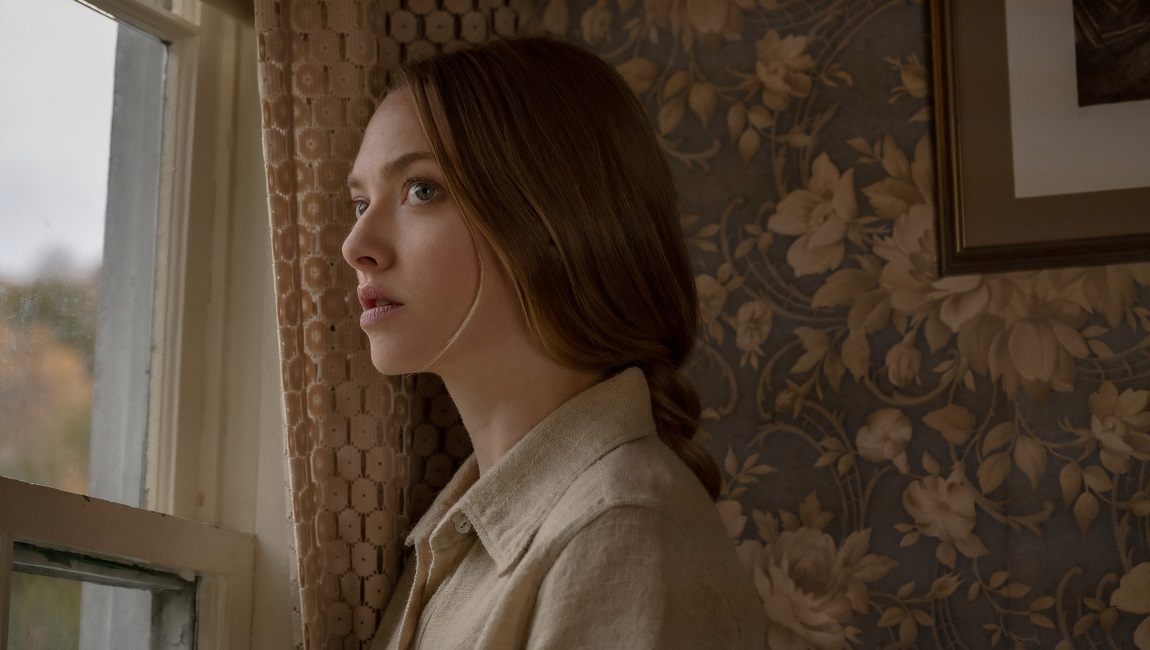Things Heard and Seen might not thrill horror purists, but its terror-flecked study of domesticity and religion both recalls genre giants and remains mostly fresh.
According to Shari Springer Berman, who co-directed Netflix’s newest adaption, Things Heard and Seen, alongside her husband Robert Pulcini, “One of the most frightening things in the world is a marriage.” Based on the novel All Things Cease to Appear by Elizabeth Brundage, Things Heard and Seen stars Amanda Seyfried and James Norton as Catherine and George Claire, who leave New York City with their young daughter after Geroge secures a teaching position at a liberal arts college upstate. Catherine, a recovering bulimic, finds herself bored, lonely, and increasingly unnerved by a sinister presence in their farmhouse. Her marriage, meanwhile, begins to unravel as George’s gaslighting and paranoia takes on echoes of the house’s tragic history.
This family drama plays out in the idyllic Hudson Valley, and the region’s rich history of metaphysical art and philosophy informs the film’s larger ideas of karma, spirituality, and the afterlife. Many of the town’s locals are devotees of 18th-century philosopher and theologian Emanuel Swedenborg, who believed that everything in the natural world had a counterpart in the spiritual realm. As the film progresses and various lies begin to unravel, this summation may prove a little too pat. Berman and Pulcini subvert this by planting a number of red herrings, including a family bible with a name ominously crossed out and a ring embedded in the house’s windowsill. A bevy of secondary characters help sort through these clues, including Stranger Things’ Natalia Dyer as a local student and F. Murray Abraham as the head of George’s department and the town’s most ardent Swedenborgian.
But Seyfried is undeniably the star, and her presence grounds the film as it crisscrosses planes and detonates secrets. Audiences see just one brief shot of Catherine at work — restoring an old church fresco, a solitary, delicate affair from which we can infer her character — before she is uprooted. George’s colleague Justine (Rhea Seehorn of Better Call Saul) is one of her few friends in the community, and comes to her aid from across the spiritual world. So too does another woman, the previous owner of the ring. Had Catherine had more (corporeal) friends, more resources, more independence, things could have ended differently for her. Then again, maybe not. The film is set in 1980, but Catherine and George’s relationship isn’t portrayed as demonstrably worse than any other miserable marriage. Many aspects of the relationship itself — lopsided power dynamics, relentless gaslighting — are depressingly timeless as far as red flags go.
In the film’s second half, Berman and Pulcini, whose directing credits include the Oscar-nominated American Splendor, explore the clash between Swedenborg’s embrace of the afterlife and humanity’s basest instincts for self-preservation and survival. George, previously portrayed as a condescending but nondescript jerk, devolves with alarming speed into a full-blown sociopath. Spinning a web of lies that would make Tom Ripley proud, he also resembles a better-dressed Jack Torrance, succumbing to a malevolent presence in an isolated house where history seems doomed to repeat itself. Horror purists might find some of the film’s theological aspects distracting, and its conclusion in particular might frustrate those who prefer justice to be meted out in a more terrestrial setting. But for Swedenborg, who believed that heaven and hell hover just beyond the fringes of what’s considered real life, divine retribution is far more righteous — and terrifying — than anything we could begin to imagine on earth.
You can stream Shari Springer Berman & Robert Pulcini’s Things Heard and Seen on Netflix beginning on April 30.







